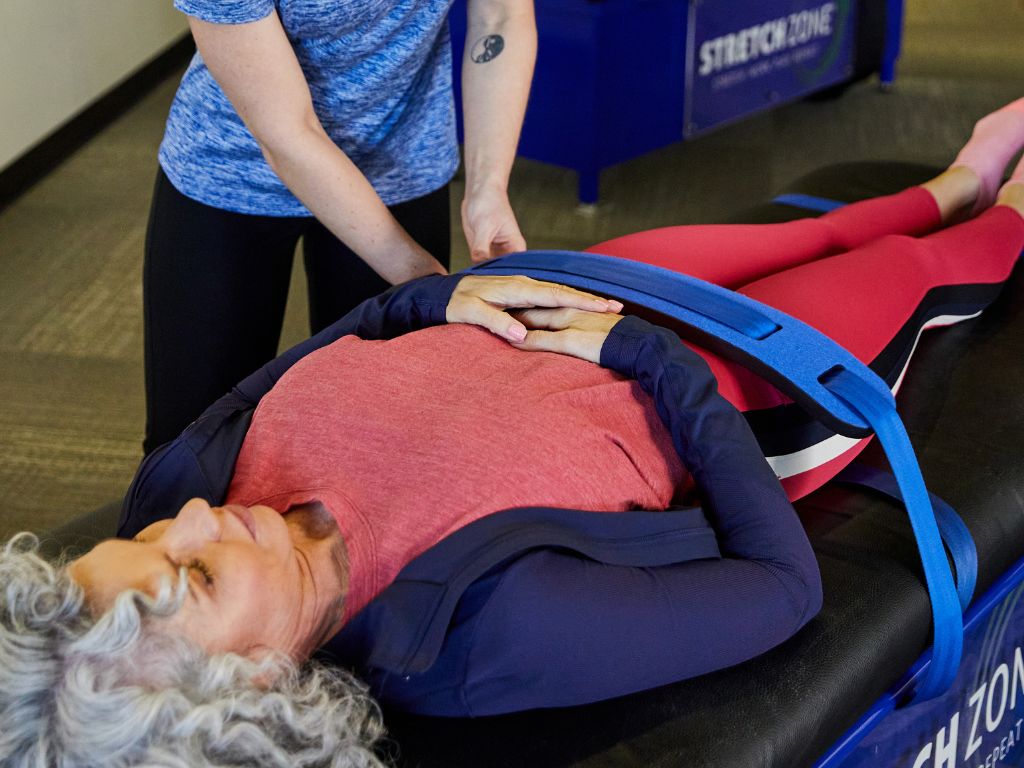
Stretching for Sedentary Lifestyles: Combatting the Effects of Sitting
Sitting for long periods of time has become the norm in our daily lives. Whether we’re stationed at our desks during work, stuck in traffic during commutes, or relaxing in front of screens at home, the hours spent sitting take a significant toll on our health.
However, breaking free from this sedentary lifestyle can be a challenge. This blog focuses on a simple yet powerful solution: stretching. By exploring the benefits of stretching, we’ll also touch on how sitting too much can lead to discomfort, like possible sciatic nerve issues. Let’s uncover how stretching and sciatic nerve stretches in particular can make a real difference in our well-being, especially when our lives revolve around sitting.
The Impact of Sedentary Lifestyles on Our Health
What’s a Sedentary Lifestyle?
A sedentary lifestyle is characterized by a pattern of minimal physical activity or movement and a lack of regular exercise. People living a sedentary lifestyle engage in little to no physical movement throughout their day, often spending extended periods sitting or reclining. This lack of activity can lead to various health risks and complications due to the body’s limited engagement in physical exertion.
The Health Dangers
Sitting isn’t as harmless as it might seem – it can have serious health implications. Here’s a breakdown of the potential dangers:
- Cardiovascular Problems: When we spend too much time sitting, our hearts miss out on crucial activity. Blood circulation slows down, and blood pressure can rise, increasing the risk of heart-related problems like heart disease and hypertension.
- Weight Gain: The lack of physical movement when sitting leads to burning fewer calories. Over time, this can contribute to weight gain and obesity, which in turn heightens the risk of diabetes, joint issues, and other obesity-related complications.
- Muscle Weakness and Bone Degradation: Sitting causes our muscles, particularly those in the back and abdomen, to become inactive. This muscle weakness can lead to back discomfort and even an increased susceptibility to injuries. Additionally, our bones need weight-bearing activities to remain strong, and prolonged sitting deprives them of this essential load-bearing.
- Poor Posture: Sitting for prolonged periods often results in poor posture, as we tend to hunch over or slouch. This unnatural positioning places strain on our back, neck, and shoulders, resulting in discomfort and potential long-term musculoskeletal problems.
- Sciatic Nerve Discomfort: Sitting for extended periods can have a direct impact on our sciatic nerve. The muscles surrounding this nerve can become tight and imbalanced, causing discomfort. This can be treated through sciatic nerve stretches.
- Mental Health Impact: While it might not be obvious, sedentary behavior can significantly impact our mental health. Extended sitting is linked to feelings of stress, anxiety, and even depression. Staying immobile can affect our mood and overall mental well-being.
How Can Stretching Help Combat the Effects of a Sedentary Lifestyle?
Stretching isn’t just about feeling limber – it provides essential advantages that can make a substantial difference in how your body feels and functions. Let’s explore the ways stretching can counteract the negative consequences of extended sitting and contribute to your overall well-being:
Addressing Muscle Imbalances and Tension
Stretching serves as a powerful tool to counteract the muscle imbalances and tension that result from prolonged sitting. By incorporating regular stretching sessions, you actively work toward rebalancing your muscle groups. This not only promotes better posture but also reduces the strain on sensitive areas, contributing to your overall comfort.
Promoting Blood Circulation and Nutrient Flow
One of the remarkable benefits of stretching is its ability to enhance blood circulation, even after extended periods of sitting. Through targeted stretches, you encourage blood flow to muscles and tissues, ensuring they receive the vital nutrients and oxygen necessary for their well-being.
Maintaining Muscle Flexibility and Range of Motion
Stretching acts as a countermeasure to the muscle stiffness that accompanies sedentary habits. By engaging in a consistent stretching routine, you actively work to maintain muscle flexibility.
Relaxing Muscle Tension and Reducing Discomfort
Stretching presents a holistic approach to relieving muscle tension and discomfort. By incorporating various stretches, you encourage muscle relaxation, leading to an improved sense of well-being. This relaxation not only minimizes discomfort but also aids with specific conditions like reducing pressure on the sciatic nerve through effective sciatic nerve stretches.
Strengthening Supporting Muscles
Supporting muscles are pivotal in maintaining proper posture and movement patterns. Proper stretching techniques focus on these essential muscles, boosting their strength and alignment.
How to Incorporate Stretching into Your Routine
Now that we understand the importance of stretching in countering the effects of a sedentary lifestyle, let’s explore how you can easily introduce stretching into your daily routine. Whether you’re looking to alleviate discomfort through sciatic nerve stretches, enhance flexibility, or simply trying to be more active, integrating stretching practices can make a significant difference.
Getting Started
- Set Reminders: In our busy lives, it’s easy to forget to move. Set reminders on your phone or computer to prompt you to stand up, stretch, and move around every hour.
- Micro-Stretching: You don’t need to block off an hour for stretching. Incorporate micro-stretches throughout the day, like gently reaching for the sky, doing wrist circles, or ankle rotations.
- Active Breaks: Use your breaks as an opportunity to stretch. During lunch or coffee breaks, take a short walk and do a few easy stretches to re-energize your body and mind.
Seek the Help of an Expert
To take your stretching routine to the next level, consider practitioner-assisted stretching. This involves working with a professional who guides you through various stretches, ensuring proper alignment and technique. Practitioner-assisted stretching can help you gradually transition away from a sedentary lifestyle.
The Benefits of Practitioner-Assisted Stretching
- Deeper Stretches for Sedentary Muscles: Practitioner-assisted stretching goes beyond what you might achieve on your own. With their guidance, you can delve into stretches that enhance your flexibility and expand your range of motion. These deeper stretches can be especially beneficial for areas that have become tight due to sitting, helping your body move more freely.
- Discomfort Relief and Healing: If sciatic nerve discomfort or other specific aches caused by prolonged sitting are troubling you, a stretch practitioner can help. They can design stretches that directly target these areas like sciatic nerve stretches for example. Moreover, as you transition away from a sedentary lifestyle, they’ll adjust your stretches to accommodate your changing needs.
- Reduced Risk of Strain and Injury: The expertise of a practitioner ensures that you’re performing stretches with proper form and technique. This minimizes the risk of straining muscles or causing injuries during your stretching routine. Their watchful eye helps you execute stretches in a way that maximizes benefits while safeguarding your well-being.
- Cultivating Mindfulness and Calmness: Practitioner-assisted stretching extends beyond the physical realm, offering a comprehensive approach to address the challenges posed by sedentary habits. Beyond the muscle-focused benefits, practitioners often integrate relaxation techniques, fostering a profound connection between your mind and body.
Seeing Results: What to Expect from Your Stretching Routine
When incorporating stretching into your routine to combat the effects of a sedentary lifestyle, changes can start becoming noticeable in a matter of weeks. Initially, you might experience increased muscle relaxation, improved flexibility, and reduced tension.
Over a few months, your range of motion may expand, contributing to better posture and comfort in daily activities. With consistent effort, the benefits of enhanced flexibility and reduced discomfort become more pronounced over time.
Tackle Sedentary Habits with Sciatic Nerve Stretches
If you’re looking to address the challenges of sedentary living through effective stretches, including sciatica stretches, as well as stretches to alleviate discomfort and enhance mobility, look no further. At Stretch Zone, we specialize in personalized stretching routines that can help alleviate stiffness, improve flexibility, and enhance your overall well-being. Take the step toward a healthier, more active lifestyle, and schedule your free session today!


